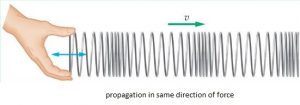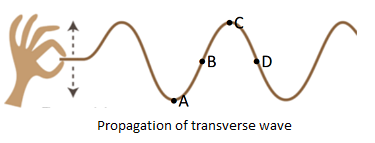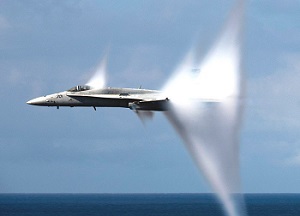Types of waves:
There are two types of waves. They are:
Longitudinal wave:
- The waves in which the particles of the medium vibrate back and forth along the direction of propagation of the wave are longitudinal wave.
- Sound waves are longitudinal waves.
- The direction of vibration is same or parallel to the wave direction as we see in case of slinky.
- When we pull or push slinky compression and rarefaction are formed.
- The regions where the coils become closer are called compressions (C) and rarefactions (R) are the region with coils are apart.

Transverse wave:
- The wave in which the particles of the medium vibrate in a direction perpendicular to the direction of propagation of the wave are called transverse wave.
- The waves produced in a stretched string is an example of transverse wave.
- Transverse wave can be transmitted in solid or liquid surfaces.

Difference between longitudinal and transverse wave:
|
Longitudinal wave |
Transverse wave |
|
The particles of the medium
vibrates in thedirection same as
the direction of wavepropagation. |
The particles of the medium has
directionperpendicular to the
direction of propagation of wave. |
|
These waves propagates in the
form of alternate compressions
and rarefactions. |
These waves travel in the form
of alternate crest and troughs. |
|
Longitudinal waves can be
transmitted through all media
i.e. solids, liquids and gases. |
Transverse waves can be
transmitted throughsolids
or over liquid surfaces. |
|
They cause changes in the
pressure and density of the
different regions of the medium
through which they pass. |
There is no change in the
pressure of mediumby
transverse wave. |
|
Examples:
(i) Waves formed over surface
of water,
(ii) Waves in stretched strings. |
Examples:
(i) Sound waves propagation
in air,
(ii) Waves formed along a
compressed slinky. |
Characteristics of a Sound wave:
The exceptional characteristics possessed by sound wave are:
- Amplitude
- wavelength
- Frequency
- Time period
- Velocity
Let’s discuss about each orderly:
Amplitude:
- It is the maximum displacement of each particle from its mean position.
- In other words, it is the height of crest.
- It is denoted by
- Its SI unit is metre(m).
- Amplitude tells about the loudness and softness of sound.
Wavelength:
- It is the distance between centers of two successive compressions or two consecutive rarefaction.
- Wavelength is denoted by λ (lamda).
- The SI unit of wavelength is metre.
Frequency:
- It is the number of vibrations per second.
- We can also define frequency as the reciprocal of time period.
- It is denoted by ν (nu).
- The SI unit of frequency is Hz (Hertz).
Time period:
- It is the absolute time taken to complete one complete vibration.
- It is denoted by T.
- Its SI unit is
- Now it is clear that ν = \(\frac{1}{T}\)
Velocity:
- It is the distance travelled by a wave in one second.
- It is denoted by v.
- It’s SI unit is m/s.
- v = \(\frac{ λ}{T}\) (here λ is wavelength and T is time period)
- So, v = λν (where ν = \(\frac{1}{T}\) )
≡ Velocity = Wavelength x Time
Pitch and loudness of sound:
Pitch:
- Pitch represents shrillness or flatness of sound.
- It depends upon the frequency of vibration.
- Higher the frequency of sound higher will be its pitch and vice versa.
Loudness:
- Loudness is the measure of the sound energy reaching the ear per second.
- It depends on the amplitude of the sound wave.
- Greater the amplitude of the sound wave greater will be its loudness and vice versa.
- It is measured in decibel (‘dB’).
Quality (timbre):
- The quality or timbre of sound depends upon the shape of sound wave produced by it.
- It is the feature or characteristic of musical sound.
- By timbre we can distinguish between two sounds of same loudness and pitch.
Tone node Note of sound:
- Pure sounds having same frequency is called
- An impure sound made from mixture of different frequencies are called
- Note is pleasant to hear.
Music and Noise:
- Music is the sound that is pleasant to hear. Sound from musical instruments are music.
- Noise is the sound which is much unpleasant to hear. Sound from bikes are noisy.

Speed of sound in different media:
The speed of sound depends upon the following conditions:
- Nature of the material medium: Sound travels with least speed in gases, faster in liquid and fastest in solids.
- Temperature: Speed of sound increases with rise in temperature.
- Humidity: As the humidity of air increases speed of sound also increases.
Speed of light is faster than that of sound. The speed of sound is 344m/s at 22⁰C in air.
Why we hear the sound of a thunder a little later than the flash of light is seen?
Sound travels with a speed which is much less than the speed of light. This is the reason we first observe lightning than hear the sound.
Sonic Boom:
- When the speed of any object is greater than that of sound then it is said to have travel with “supersonic speed”.
- Aircrafts, rockets have supersonic speed.
- When the object travels with supersonic speed it produces shock waves in air.
- Shock waves produces explosive noise which in-turn called sonic boom.
- A tremendous amount of energy is released by sonic boom which breaks glass panes, windows etc.

Audible frequency of sound:
- Human’s ear has audible range of frequency from 20Hz and 20,000Hz.
- Sound class 9 notes are full of theory and illustration.